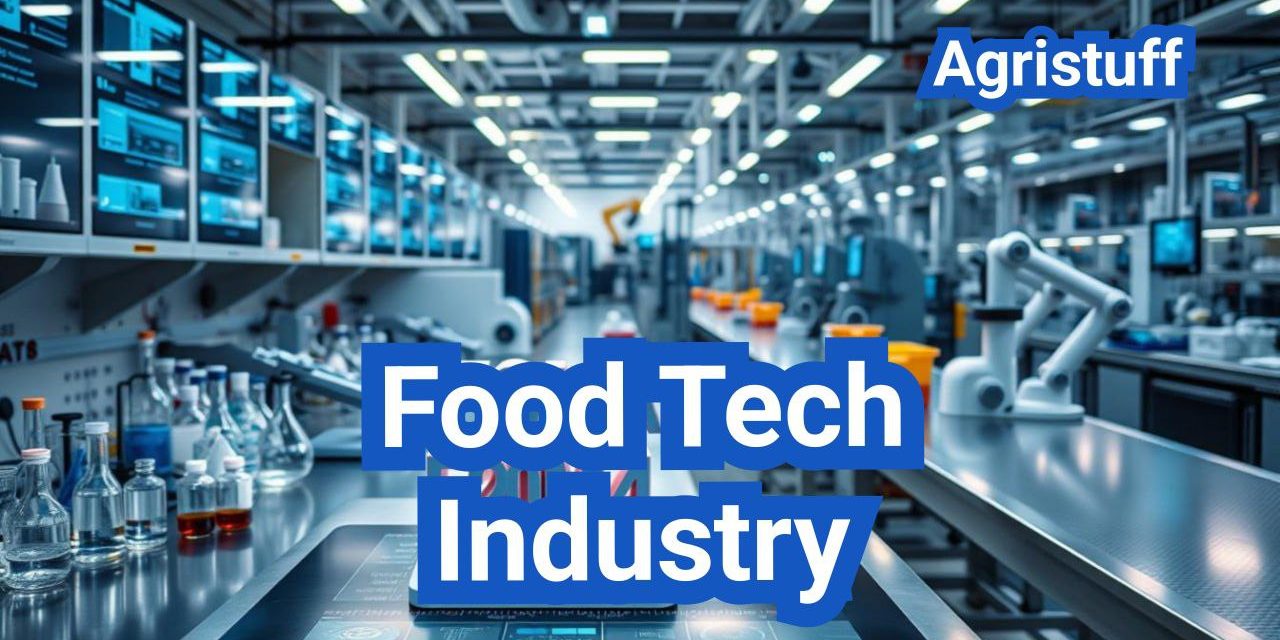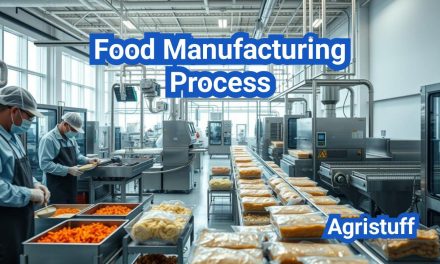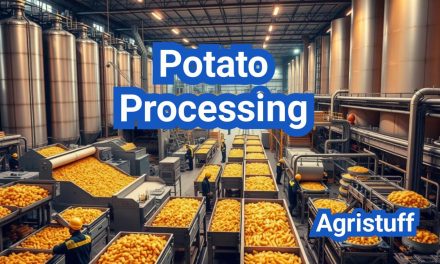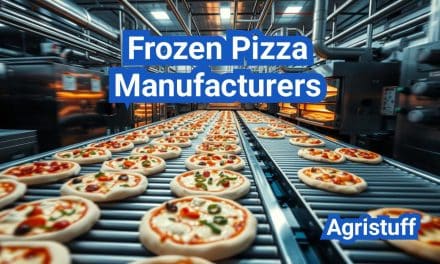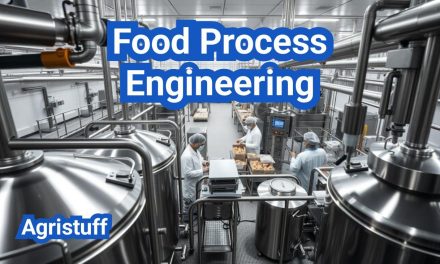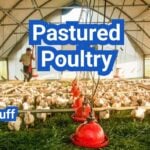The U.S. is witnessing a significant surge in the food tech industry, driven by innovative startups that are revolutionizing the way we produce, consume, and interact with food and beverages.
Companies like Liquid Death and Meati are making headlines with their unique approaches to sustainable products and meat alternatives.
The smart factory trends in the food and beverage sector are also gaining momentum, with a focus on automation, efficiency, and sustainability.
Key Takeaways
- The U.S. food tech industry is experiencing rapid growth.
- Startups are driving innovation in food delivery and sustainable products.
- Companies like Liquid Death and Meati are leading the way.
- Smart factory trends are improving efficiency and sustainability.
- The industry is expected to continue its upward trend.
The State of the Food Tech Industry in the U.S.
The U.S. food tech industry is experiencing significant growth, driven by innovation and investment. This growth is transforming the way food is produced, processed, and consumed across the country.
Market Size and Growth Projections
The food tech industry in the U.S. has seen substantial investment in recent years, with the market size expected to grow steadily. According to industry reports, the market is projected to expand at a compound annual growth rate (CAGR) of 10% over the next five years.
| Year | Market Size (USD Billion) | Growth Rate (%) |
|---|---|---|
| 2023 | 15 | 8 |
| 2024 | 16.5 | 10 |
| 2025 | 18.2 | 12 |
Key Players and Market Segments
The U.S. food tech industry is characterized by a diverse range of players, from startups to established corporations. Key segments include alternative proteins, vertical farming, and food delivery platforms. Companies like Beyond Meat and Impossible Foods are leading the way in alternative proteins, while startups like Plenty are pioneering vertical farming.
Regional Hubs for Food Tech Innovation
The U.S. is home to several regional hubs for food tech innovation, with cities like San Francisco, New York, and Boston emerging as major centers. These hubs are driving innovation through a combination of startup activity, investment, and research institutions.
Key Regional Hubs:
- San Francisco Bay Area
- New York City
- Boston
- Los Angeles
How to Navigate the Food Tech Ecosystem

Navigating the food tech ecosystem requires a deep understanding of its diverse categories and how they intersect with other industries. The food tech landscape is rapidly evolving, driven by technological advancements, changing consumer behaviors, and the need for sustainable practices.
Categories Within Food Tech
Food tech encompasses a wide range of categories, including:
- Sustainable Production: Innovations aimed at reducing environmental impact.
- Food Delivery and Meal Kits: Services that provide convenience and personalized nutrition.
- Food Processing and Packaging: Technologies that enhance efficiency and product safety.
These categories are not mutually exclusive; they often overlap and converge to create comprehensive solutions.
Understanding the Value Chain: From Farm to Fork
The food tech value chain spans from agricultural production to consumption. Key stages include:
- Production: Where sustainable farming practices and precision agriculture play a crucial role.
- Processing: Where technology enhances food safety and quality.
- Distribution: Where logistics and supply chain management are optimized.
- Consumption: Where consumer preferences drive demand for innovative products.
Identifying Convergence with Other Industries
Food tech converges with other industries such as technology, sustainability, and healthcare. For instance, advancements in AI and IoT are transforming food production and processing. Similarly, the focus on sustainability is driving innovations in packaging and waste reduction.
By understanding these convergences, stakeholders can identify opportunities for collaboration and innovation, ultimately driving growth in the food tech sector.
Identifying Emerging Food Tech Industry Trends
Consumer behavior shifts are driving a wave of innovation in the food tech industry, with a focus on sustainability and healthy eating. As consumers become more environmentally conscious and health-aware, food tech companies are responding with cutting-edge solutions.
Consumer Behavior Shifts Driving Innovation
The way consumers interact with food is changing. There’s a growing demand for sustainable, healthy, and convenient food options. This shift is driving innovation in food tech, with companies developing new products and services that cater to these needs. Some key trends include:
- Increased demand for plant-based and vegan products
- Growing popularity of online grocery shopping and meal kits
- Rise of food delivery services that prioritize sustainability
Sustainability and Environmental Impact
Sustainability is becoming a critical factor in the food tech industry. Companies are leveraging technology to reduce their environmental footprint, from reducing food waste to implementing sustainable packaging. Some examples include:
- Using AI to optimize supply chains and reduce waste
- Implementing biodegradable packaging solutions
- Developing vertical farming techniques to reduce land use
Health and Nutrition Technology Advancements
Health and nutrition technology is another area of significant innovation in the food tech industry. Companies are developing new products and services that prioritize nutritional value and health benefits. Some examples include:
- Personalized nutrition plans based on genetic data
- Development of functional foods with enhanced nutritional value
- Use of probiotics and prebiotics to support gut health
Implementing Smart Factory Solutions in Food and Beverage
Implementing smart factory solutions is becoming a priority for food and beverage manufacturers looking to stay competitive. The integration of advanced technologies such as IoT sensors, manufacturing execution systems, and predictive maintenance is transforming the industry.
Core Components of a Smart Food Factory
A smart food factory relies on several core components to optimize production processes. These include:
IoT Sensors and Data Collection Systems
IoT sensors play a crucial role in collecting real-time data on production processes, enabling manufacturers to make informed decisions.
Integrated Manufacturing Execution Systems
Manufacturing execution systems (MES) integrate with other factory systems to provide a comprehensive view of production, enhancing efficiency and compliance.
Predictive Maintenance Technologies
Predictive maintenance technologies use data analytics and machine learning to predict equipment failures, reducing downtime and maintenance costs.
Step-by-Step Implementation Roadmap
To implement smart factory solutions effectively, manufacturers should follow a step-by-step roadmap:
- Assess current production processes and identify areas for improvement.
- Select appropriate technologies that align with production goals.
- Implement IoT sensors and data collection systems.
- Integrate manufacturing execution systems.
- Deploy predictive maintenance technologies.
Measuring ROI and Success Metrics
To measure the success of smart factory initiatives, manufacturers should track key performance indicators (KPIs) such as:
| KPI | Description | Target |
|---|---|---|
| Overall Equipment Effectiveness (OEE) | Measures the efficiency of equipment | >85% |
| Production Cycle Time | Time taken to complete a production cycle | Reduction by 20% |
| Maintenance Costs | Costs associated with maintaining equipment | Reduction by 15% |
By implementing smart factory solutions and tracking these KPIs, food and beverage manufacturers can achieve significant improvements in efficiency and cost savings.
Achieving FSMA204 Traceability Compliance

Achieving FSMA204 traceability compliance is a complex process that requires a thorough understanding of the regulatory requirements and effective technology solutions. The FSMA204 regulation mandates that food companies implement traceability systems to track products throughout the supply chain, ensuring product safety and regulatory compliance.
Understanding the Regulatory Requirements
The FSMA204 regulation requires food companies to maintain detailed records of their products, including origin, processing, and distribution information. Companies must be able to identify and track products at every stage of the supply chain, from farm to fork. This involves implementing robust tracking systems and maintaining accurate records to ensure compliance.
Selecting Technology Solutions for Compliance
To achieve FSMA204 compliance, companies need to select technology solutions that can effectively track and trace products throughout the supply chain. This may involve implementing barcode scanning, RFID tagging, or other tracking technologies. The chosen solution should be scalable, reliable, and integrated with existing systems to ensure seamless data collection and reporting.
Implementation Guide and Timeline
Implementing FSMA204 traceability compliance requires a structured approach. Companies should start by assessing their current tracking capabilities, followed by selecting and implementing a suitable technology solution. A detailed timeline should be established, including milestones for system integration, testing, and training. Regular audits and updates will ensure ongoing compliance with the regulation.
By understanding the regulatory requirements, selecting the right technology solutions, and following a structured implementation guide, food companies can achieve FSMA204 traceability compliance and maintain a competitive edge in the market.
Integrating Automation and Robotics in Food Manufacturing
Food manufacturing is on the cusp of a technological transformation with automation and robotics. As the industry continues to evolve, manufacturers are looking for ways to improve efficiency, reduce labor costs, and enhance product quality.
Assessing Automation Opportunities
The first step in integrating automation and robotics is to assess opportunities for improvement. Manufacturers should identify areas where automation can have the greatest impact, such as in production lines, packaging, or material handling. By analyzing production workflows and identifying bottlenecks, manufacturers can determine where automation can help streamline processes.
Deploying Collaborative Robots (Cobots)
Collaborative robots, or cobots, are designed to work alongside human workers, enhancing productivity and safety. When deploying cobots, manufacturers should consider several factors.
Selection Criteria for Food-Safe Cobots
Cobots used in food manufacturing must meet strict safety and hygiene standards. Manufacturers should select cobots that are designed for food-safe applications and can withstand the rigors of the production environment.
Integration with Existing Production Lines
Cobots should be integrated seamlessly with existing production lines to minimize disruptions and maximize efficiency. This requires careful planning and coordination with production staff.
Safety Protocols and Certifications
Manufacturers must ensure that cobots are installed and operated in accordance with safety protocols and certifications, such as those set by OSHA or ISO. Regular maintenance and training are also crucial to ensuring safe operation.
“The use of cobots in food manufacturing is not just about improving efficiency; it’s also about enhancing worker safety and product quality.”
— John Smith, Food Manufacturing Expert
Training Workforce for Automation
As automation and robotics become more prevalent, it’s essential to train the workforce to work effectively with these new technologies. Manufacturers should invest in training programs that teach workers how to operate, maintain, and troubleshoot automated systems.
| Training Topic | Description | Duration |
|---|---|---|
| Cobot Operation | Training on the safe operation of cobots | 2 days |
| Automated System Maintenance | Training on maintaining automated systems | 3 days |
| Troubleshooting | Training on troubleshooting automated systems | 2 days |
By integrating automation and robotics, food manufacturers can improve efficiency, reduce costs, and enhance product quality. With careful planning, deployment, and training, manufacturers can reap the benefits of these technologies.
Capitalizing on the eGrocery Market in America

The eGrocery market in America is on the cusp of a revolution, driven by changing consumer behaviors and technological advancements. As the demand for online grocery shopping continues to grow, businesses must adapt to stay competitive.
Current Market Landscape and Growth Opportunities
The current market landscape of the eGrocery industry in the U.S. is characterized by rapid growth and increasing competition. According to recent trends, the market is expected to continue growing, driven by consumer demand for convenience and flexibility.
Key statistics:
| Year | Market Size | Growth Rate |
|---|---|---|
| 2022 | $100 billion | 15% |
| 2023 | $115 billion | 12% |
| 2024 | $130 billion | 10% |
Building Technology Infrastructure
To capitalize on the growing eGrocery market, businesses must invest in robust technology infrastructure. This includes developing user-friendly e-commerce platforms, implementing efficient inventory management systems, and leveraging data analytics to inform business decisions.
Key technology infrastructure components:
- E-commerce platforms
- Inventory management systems
- Data analytics tools
Optimizing Last-Mile Delivery
Last-mile delivery is a critical component of the eGrocery market, as it directly impacts customer satisfaction and loyalty. To optimize last-mile delivery, businesses can leverage technologies such as route optimization software and real-time tracking.
By understanding the current market landscape, building robust technology infrastructure, and optimizing last-mile delivery, businesses can capitalize on the growing eGrocery market in America.
Strategies for Midstream Food Digitization

Midstream food digitization involves the adoption of advanced technologies to streamline processes and improve traceability. As the food industry continues to evolve, companies are looking for ways to leverage technology to enhance their operations.
Digital Transformation of Supply Chains
Digital transformation is a critical aspect of midstream food digitization. It involves the integration of digital technologies into all areas of the supply chain, from production to distribution. This can include the use of blockchain for traceability, IoT devices for real-time monitoring, and data analytics for informed decision-making.
By adopting digital technologies, companies can improve supply chain efficiency, reduce costs, and enhance product quality. For instance, the use of blockchain technology can help track the origin and movement of goods, reducing the risk of contamination and improving food safety.
Implementing Data Integration and Analytics
Data integration and analytics are crucial for making informed decisions in the midstream food sector. By integrating data from various sources, companies can gain a comprehensive view of their operations and identify areas for improvement.
| Benefit | Description |
|---|---|
| Improved Efficiency | Streamlined processes through data-driven insights |
| Enhanced Quality Control | Real-time monitoring and predictive analytics |
| Reduced Costs | Minimized waste and optimized resource allocation |
Learning from Successful Case Studies
Several companies have successfully implemented midstream food digitization strategies, achieving significant benefits. For example, a leading food manufacturer implemented a digital twin solution to optimize their production process, resulting in a 15% reduction in energy consumption.
Securing Food Operations with Industrial Cybersecurity

With the rise of digitalization in the food sector, protecting operations from cyber threats is more critical than ever. Industrial cybersecurity is crucial for safeguarding food operations, ensuring product safety, and maintaining consumer trust.
Conducting Vulnerability Assessments
Conducting thorough vulnerability assessments is the first step in securing food operations. This involves identifying potential entry points for cyber threats and evaluating the robustness of existing security measures. By understanding vulnerabilities, food manufacturers can take proactive steps to mitigate risks.
Implementing Security Protocols
Implementing robust security protocols is essential for protecting food operations from cyber threats. This includes:
Network Segmentation Strategies
Dividing networks into segments to limit the spread of malware.
Access Control Systems
Restricting access to sensitive areas of the network and systems.
Secure Remote Access Solutions
Ensuring that remote access to systems is secure and monitored to prevent unauthorized access.
| Security Measure | Description | Benefit |
|---|---|---|
| Network Segmentation | Dividing networks into secure segments | Reduces malware spread |
| Access Control | Restricting access to authorized personnel | Enhances data protection |
| Secure Remote Access | Securely accessing systems remotely | Prevents unauthorized access |
Developing Incident Response Plans
Despite best efforts, cyber incidents can still occur. Developing comprehensive incident response plans is crucial for minimizing the impact of such events. These plans should outline procedures for responding to incidents, containing damage, and restoring operations.
By prioritizing industrial cybersecurity, food manufacturers can protect their operations, ensure compliance with regulations, and maintain consumer trust.
Developing a Food Safety Culture Through Technology

With the growing emphasis on food safety, companies are turning to technology to foster a culture of safety within their organizations. This involves leveraging digital tools and strategies to enhance safety management, engage employees, and monitor performance.
Deploying Digital Tools for Safety Management
Digital tools play a crucial role in modernizing food safety management. These tools can range from software solutions for tracking and tracing products to mobile apps that facilitate real-time reporting of safety incidents. By deploying such digital tools, companies can streamline their safety management processes, making them more efficient and effective.
Engaging Employees Through Training Programs
Employee engagement is a critical component of a strong food safety culture. Training programs that utilize technology, such as e-learning modules and virtual reality simulations, can significantly enhance employee understanding and compliance with safety protocols. These programs not only educate employees on the importance of food safety but also equip them with the knowledge and skills needed to maintain high safety standards.
Establishing Safety Performance Metrics
To measure the effectiveness of their food safety culture, companies need to establish clear safety performance metrics. These metrics can include incident frequency rates, compliance scores, and employee training completion rates. By tracking these metrics, companies can identify areas for improvement and make data-driven decisions to enhance their safety culture.
| Safety Performance Metric | Description | Benefit |
|---|---|---|
| Incident Frequency Rate | Measures the number of safety incidents per unit of time. | Helps identify trends and areas for improvement. |
| Compliance Scores | Evaluates adherence to safety regulations and standards. | Ensures regulatory compliance and reduces risk. |
| Employee Training Completion Rates | Tracks the percentage of employees completing safety training. | Ensures that employees are equipped with necessary safety knowledge. |
Leveraging AI for Quality Inspection in Food Production

The integration of AI in quality inspection processes is enhancing food production efficiency. By leveraging AI for quality inspection, food manufacturers can significantly reduce costs and improve product quality.
Implementing Machine Vision Systems | Food Tech Industry
One of the key applications of AI in quality inspection is through machine vision systems. These systems use cameras and AI algorithms to inspect products on the production line, detecting defects or contaminants that may not be visible to the human eye.
System Integration and Calibration Steps | Food Tech Industry
To effectively implement machine vision systems, several steps are involved. First, the system must be integrated with existing production line equipment. Then, it must be calibrated to recognize specific products and defects.
| Step | Description |
|---|---|
| 1. System Design | Designing the machine vision system to fit the production line. |
| 2. Integration | Integrating the system with existing equipment. |
| 3. Calibration | Calibrating the system to recognize products and defects. |
Continuous Improvement Through Data Analysis | Food Tech Industry
AI systems can analyze data from quality inspections to identify trends and areas for improvement. This allows for continuous improvement in the production process, enhancing efficiency and product quality.
By leveraging AI and machine vision systems, food manufacturers can achieve higher levels of quality control and reduce waste, ultimately improving their bottom line.
Achieving Industrial Decarbonization in Food Manufacturing

Achieving industrial decarbonization is a complex challenge that food manufacturers are tackling through innovative technologies and strategies. As the industry continues to evolve, companies are under increasing pressure to reduce their environmental impact while maintaining productivity and efficiency.
Energy Efficiency Technology Implementation | Food Tech Industry
One key approach to industrial decarbonization is the implementation of energy-efficient technologies. This can include upgrading to LED lighting, optimizing heating and cooling systems, and using energy-efficient equipment. By reducing energy consumption, food manufacturers can lower their carbon footprint and achieve significant cost savings.
Energy-efficient technologies not only reduce energy consumption but also enhance overall operational efficiency.
Integrating Renewable Energy Sources | Food Tech Industry
Another crucial strategy is the integration of renewable energy sources into food manufacturing operations. Solar, wind, and biogas energy can significantly reduce reliance on fossil fuels. Companies can install solar panels on rooftops or invest in renewable energy credits to offset their energy consumption.
“The adoption of renewable energy is a critical step towards achieving a sustainable future for the food manufacturing industry.” – Industry Expert
Developing Carbon Footprint Reduction Strategies
Developing comprehensive carbon footprint reduction strategies is essential for achieving industrial decarbonization. This involves conducting thorough assessments of current emissions, identifying areas for improvement, and implementing targeted reduction measures. Strategies may include process optimization, supply chain adjustments, and the adoption of new technologies.
By implementing these strategies, food manufacturers can make significant progress towards their sustainability goals. Continuous monitoring and improvement are key to maintaining momentum in carbon footprint reduction efforts.
Launching and Scaling a Food Tech Startup

To succeed in the competitive food tech landscape, startups need to conduct meticulous market research and develop a viable business model. Launching and scaling a food tech startup involves several critical steps that require careful planning and execution.
Conducting Market Research
Effective market research is the foundation of a successful food tech startup. It involves understanding consumer needs, identifying trends, and analyzing competitors.
Identifying Market Gaps and Opportunities | Food Tech Industry
Startups must identify gaps in the market that their product or service can fill. This involves analyzing consumer behavior and preferences to find unmet needs.
Competitor Analysis Techniques
Understanding the competitive landscape is crucial. Techniques include analyzing competitors’ strengths, weaknesses, and market strategies to identify opportunities for differentiation.
Customer Validation Methods
Validating customer assumptions is essential. Methods include surveys, focus groups, and pilot testing to ensure that the product or service meets customer needs.
Developing a Viable Business Model | Food Tech Industry
A viable business model is critical for the sustainability of a food tech startup. It involves creating a revenue stream that is aligned with the company’s value proposition.
Key components include understanding cost structures, revenue streams, and key partnerships that drive growth and profitability.
Building Strategic Partnerships | Food Tech Industry
Strategic partnerships can drive growth and innovation for food tech startups. These partnerships can provide access to new markets, technologies, and resources.
By partnering with established companies, startups can leverage their expertise and networks to scale their operations and improve their competitive edge.
Securing Funding for Food Tech Ventures
To drive growth and innovation, food tech ventures must navigate various funding options. Securing the right funding is crucial for these ventures to scale their operations and bring their innovative solutions to market.
Funding Options for Food Tech Ventures | Food Tech Industry
Understanding the available funding options is the first step towards securing capital. Food tech ventures can explore venture capital investments, angel investors, crowdfunding, and grants and government funding.
- Venture capital investments
- Angel investors
- Crowdfunding
- Grants and government funding
Venture capital firms specializing in food tech can provide significant funding and valuable industry insights. Angel investors, on the other hand, can offer more flexible investment terms and early-stage support.
Crafting Compelling Investor Pitches | Food Tech Industry
A well-crafted investor pitch is essential for attracting funding. It should clearly articulate the venture’s value proposition, market potential, and competitive advantage.
- A concise and compelling narrative
- Data-driven market analysis
- A robust business model
Investors are looking for ventures with a clear path to scalability and return on investment. Demonstrating traction through early customers or pilot projects can significantly enhance the pitch.
Targeting Current Investment Hotspots | Food Tech Industry
The food tech industry is witnessing significant investment activity in areas such as sustainable agriculture, alternative proteins, and food waste reduction.
| Investment Area | Description | Potential Impact |
|---|---|---|
| Sustainable agriculture | Technologies improving crop yields and reducing environmental impact | Enhanced food security and reduced carbon footprint |
| Alternative proteins | Innovations in plant-based and lab-grown meat alternatives | Reduced reliance on traditional livestock farming |
| Food waste reduction | Solutions aimed at minimizing food waste throughout the supply chain | Reduced waste and improved resource efficiency |
By understanding these investment hotspots, food tech ventures can tailor their pitches and business models to attract funding from investors focused on these areas.
Preparing for the Future of Food Tech
The future of food tech is rapidly unfolding, driven by technological advancements and shifting consumer behaviors. As the industry continues to evolve, it’s essential to stay informed about emerging trends and innovations that are set to transform the food tech landscape.
Key trends to watch include the integration of artificial intelligence and machine learning in food production, the rise of smart factories, and the growing importance of sustainability and environmental stewardship. These developments will not only enhance operational efficiency but also drive innovation in the food tech sector.
To remain competitive, businesses must be prepared to adapt to these changes and invest in technologies that support the future of food tech. By doing so, they can capitalize on new opportunities, improve their bottom line, and contribute to a more sustainable food system.
As the food tech industry continues to grow and mature, it’s clear that innovation will play a critical role in shaping its future. By embracing the latest food tech trends and advancements, companies can position themselves at the forefront of this exciting and rapidly evolving industry.
FAQ
What is the current state of the food tech industry in the U.S.?
The food tech industry in the U.S. is experiencing a surge in innovation, driven by startups that are leveraging technology to create new markets in food delivery, sustainable products, and more.
What are the key trends driving the food tech industry?
Key trends driving the food tech industry include consumer behavior shifts, sustainability, and health and nutrition technology advancements.
What is food tech, and how does it differ from food science?
Food tech refers to the application of technology to improve the food industry, whereas food science is the study of the physical, biological, and chemical makeup of food.
What are some examples of food tech activities?
Examples of food tech activities include sustainable production, food delivery, and the use of AI for quality inspection in food production.
How is technology changing the food industry?
Technology is changing the food industry by improving efficiency, reducing labor costs, and enabling the creation of new products and services.
What is the role of smart factory solutions in the food and beverage industry?
Smart factory solutions are crucial for the food and beverage industry to remain competitive, enabling real-time monitoring, predictive maintenance, and optimized production.
What is FSMA204 traceability compliance, and why is it important?
FSMA204 traceability compliance refers to the ability to track and trace food products throughout the supply chain, ensuring product safety and regulatory compliance.
How can food companies achieve FSMA204 traceability compliance?
Food companies can achieve FSMA204 traceability compliance by implementing technology solutions, such as data integration and analytics, and selecting the right technology partners.
What is the importance of industrial cybersecurity in food operations?
Industrial cybersecurity is essential to protect against cyber threats and ensure product safety, requiring vulnerability assessments, security protocols, and incident response plans.
How can food tech startups secure funding?
Food tech startups can secure funding by understanding funding options, creating compelling investor pitches, and targeting current investment hotspots in the food tech industry.
What are the benefits of leveraging AI for quality inspection in food production?
Leveraging AI for quality inspection in food production improves efficiency, reduces costs, and enables continuous improvement through data analysis.
How can food manufacturers achieve industrial decarbonization?
Food manufacturers can achieve industrial decarbonization by implementing energy efficiency technologies, integrating renewable energy sources, and developing carbon footprint reduction strategies.
What is the eGrocery market, and what are its growth opportunities?
The eGrocery market refers to the online grocery shopping and delivery market, with growth opportunities driven by consumer demand and technology infrastructure.
How can food companies develop a food safety culture?
Food companies can develop a food safety culture by deploying digital tools for safety management, engaging employees through training programs, and establishing safety performance metrics.
Conclusion of: Food Tech Industry
Food Tech Industry: Startups, Funding, and Smart Factory Trends in the U.S.
The food tech industry in the United States blends software, advanced biology, and manufacturing into one fast-moving ecosystem—from robotics on farms to AI in plants and traceability in retail. After a hype cycle and reset, momentum is returning around practical wins: safer operations, data-driven quality, and compliance that protects brands and consumers alike ( FDA: New Era of Smarter Food Safety ).
Why the food tech industry matters in the U.S. economy
Underneath the food tech industry sits one of America’s largest manufacturing bases—food and beverage processing—which employs a significant workforce and supplies every aisle from meat and dairy to beverages and grain products. Digital tools, automation, and analytics layered onto this base are where productivity and safety advances compound ( USDA ERS: Food & Beverage Manufacturing ).
Funding snapshot and investor sentiment
Funding for the food tech industry (often tracked as “agrifoodtech”) showed signs of stabilization in 2024, with investors gravitating toward business models that can prove unit economics and a clear path to profitability. The big picture is a gradual recovery with quality deals still getting done ( AgFunder: 2025 Global AgriFoodTech Report ).
Within the U.S. food tech industry, capital has been concentrating in AI-enabled midstream and downstream solutions—think forecasting, inventory quality, and last-mile efficiency—while upstream biotech and robotics remain strategic priorities for corporates and select VCs ( AgFunderNews: 2024 wrap ).
Still, the food tech industry faces broader venture headwinds; investors are more selective and timelines are longer. Bright spots include precision robotics and energy-adjacent plays that improve plant reliability and costs—areas where industrial buyers feel value quickly ( Reuters: U.S. agtech capital trends ).
What’s winning: categories and startup themes
Midstream digitization is a core theme in the food tech industry: data platforms that sit between suppliers, co-packers, and retailers to orchestrate traceability, quality, and demand planning. These solutions thrive because they reduce waste and recalls while improving service levels ( AgFunderNews: midstream momentum ).
Downstream, the food tech industry is reinventing eGrocery, retail media, and restaurant tech with smarter routing, dynamic inventory, and personalization. Upstream, advances in farm automation and novel ingredients continue as consumers demand consistent quality and sustainability ( AgFunder: category overview ).
Alternative proteins remain a visible frontier for the food tech industry. A watershed came when federal regulators cleared cultivated chicken for sale, enabling pilot launches and accelerating R&D roadmaps for novel foods ( Reuters: cultivated meat approvals ).
Policy also shapes adoption in the food tech industry: some U.S. states have moved to restrict cultivated meat, affecting where pilots can run and how brands plan go-to-market strategies alongside federal allowances ( AP: state policy landscape ).
Smart factory adoption and Industry 4.0
Inside plants, the food tech industry is accelerating smart manufacturing to gain agility and resilience. The latest industrial surveys show sizable budgets for automation, analytics, and cybersecurity—paired with workforce upskilling to realize ROI ( Deloitte: 2025 Smart Manufacturing Survey ).
The food tech industry increasingly integrates MES/SCADA with cloud analytics, uses AI/ML for quality inspection and demand planning, and deploys connected sensors to lift OEE and reduce downtime. Sector snapshots indicate widespread adoption and near-term plans to scale AI ( Rockwell Automation: CPG Smart Manufacturing ).
Predictive maintenance has gone mainstream in the food tech industry, using machine data from fillers, ovens, and packers to prevent unplanned stops, extend asset life, and secure product quality—especially critical for high-throughput lines ( Food Engineering/PMMI: predictive maintenance ).
As connectivity grows, the food tech industry must harden operational technology. Applying ICS security guidance for segmentation, monitoring, and incident response reduces risk and protects production continuity ( NIST SP 800-82 Rev. 3: ICS/OT Security ).
Robotics and cobots are scaling in the food tech industry for tasks from sanitation to palletizing, with safety resources outlining responsible deployment and training in food environments ( OSHA: Robotics overview ).
Traceability & compliance road map
Traceability has become a structural mandate for the food tech industry. The FDA’s New Era blueprint calls for tech-enabled traceability, smarter prevention, and a food safety culture that leverages digital records end-to-end ( FDA: New Era blueprint ).
The Food Traceability Rule (FSMA 204) sets data requirements for certain foods; regulators have discussed extending the compliance horizon, giving the food tech industry more time to implement interoperable systems and Key Data Elements across partners ( FDA: FSMA 204 rule ).
Standards bodies are stepping in to help the food tech industry. GS1 US offers practical toolkits and promotes EPCIS event data to support recall readiness and rapid investigations aligned to FSMA 204 ( GS1 US: FSMA 204 resources ).
For interoperability, the food tech industry is adopting EPCIS 2.0—a global standard to exchange event-level data (commissioning, shipping, receiving) across suppliers, co-packers, DCs, and retailers ( GS1: EPCIS 2.0 standard ).
Market size & labor context
Because meat, dairy, beverages, and grain/oilseed processing account for large shares of sales, the food tech industry often targets these segments first for automation, analytics, and packaging innovation to capture outsized ROI ( USDA ERS: sector profile ).
Employment in U.S. food manufacturing has trended upward, giving the food tech industry a sizable workforce to augment with digital work instructions, AI copilots for line leads, and smarter QA—boosting throughput without compromising safety ( FRED (BLS): NAICS 311 index ).
Decarbonization & energy priorities
Energy and emissions are becoming a new ROI pillar for the food tech industry. Federal analyses highlight pathways such as efficiency, electrification, low-carbon fuels, and carbon capture—many of which align naturally with smart factory upgrades ( DOE: Industrial Decarbonization Pathways ).
In practice, the food tech industry can harvest near-term wins by targeting compressed air, refrigeration, and motors—while planning longer-term transitions for process heat, ovens, and packaging lines to meet corporate sustainability targets ( Food Industry Executive: decarbonizing food ).
Execution playbook for brands and plants
Anchor the business case in the food tech industry: translate initiatives into OEE, yield, energy intensity, and complaint-rate improvements; leaders pair capital projects with analytics and workforce enablement to secure multi-site ROI ( Deloitte: smart manufacturing survey ).
Harden OT early in the food tech industry. Segment PLCs and HMIs, monitor traffic, and plan incident response so that cyber events don’t become food safety or uptime events ( NIST SP 800-82: ICS/OT security ).
Design for traceability in the food tech industry: map Key Data Elements to master data, choose identifiers, and pilot EPCIS sharing with co-packers ahead of FSMA 204 timelines ( FDA: FSMA 204 ).
Invest where people and data meet in the food tech industry. Train operators and quality teams to trust digital twins, SPC alerts, and AI suggestions; adoption curves steepen when frontline users experience quick wins ( Rockwell: CPG smart manufacturing ).
Policy & certification watch
Federal regulators remain central to innovation in the food tech industry. Approvals for cultivated chicken signaled openness to novel foods provided safety and labeling guardrails are met ( Reuters: cultivated meat approval ).
State-level actions now shape go-to-market considerations for the food tech industry, making compliance mapping by product and jurisdiction essential to de-risk pilots and commercialization paths ( AP: state bans & restrictions ).
Beyond regulation, certification frameworks guide the food tech industry on culture and systems. GFSI-benchmarked standards such as BRCGS reinforce risk-based controls and continuous improvement—complementary to FDA’s tech-forward approach ( BRCGS: Food Safety Standard ).
Outlook 2025–2027
The U.S. food tech industry will reward operators who pair traceability with measurable factory ROI—predictive maintenance, targeted waste cuts, faster changeovers—while staying diligent on OT security and workforce readiness. Capital will remain selective, favoring teams with evidence of efficiency and resilience ( Deloitte: 2025 outlook ).
Final thought
The food tech industry has shifted from headlines to execution. Leaders standardize data, design for compliance, secure their plants, and coach teams to use AI where it matters—on yield, quality, and uptime. That’s how U.S. brands turn innovation into durable advantage in the years ahead ( FDA: New Era blueprint ).
Sources & References
- AgFunder: 2025 Global AgriFoodTech Investment Report
- AgFunderNews: 2024 funding wrap
- Reuters: U.S. agtech capital trends
- USDA ERS: Food & Beverage Manufacturing
- FRED (BLS): NAICS 311 employment index
- Deloitte: 2025 Smart Manufacturing Survey
- Rockwell Automation: CPG Smart Manufacturing
- NIST SP 800-82 Rev. 3 (ICS/OT Security)
- OSHA: Robotics
- FDA: New Era of Smarter Food Safety
- FDA: FSMA 204 Traceability Rule
- GS1 US: FSMA 204 resources
- GS1: EPCIS 2.0
- Reuters: Cultivated meat approvals
- AP: State actions on cultivated meat
- Food Industry Executive: Decarbonizing food
- DOE: Industrial Decarbonization Pathways
- Food Engineering/PMMI: Predictive maintenance
- BRCGS: Food Safety Standard

